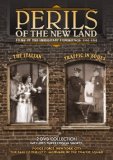
|
Perils Of The New Land: Films of the Immigrant Experience (1910 - 1915) - Traffic in Souls / The Italian |
By DAVE KEHR
Published: August 11, 2008
PERILS OF THE NEW LAND
Flicker Alley
Another intriguing compilation from the silent-film specialist Flicker Alley, “Perils of the New Land” brings together two early features and three short films set in a New York City (that of 1910 to 1915) still being fed by waves of European immigrants.
George Loane Tucker’s 1913 “Traffic in Souls” was one of the earliest American feature-length films (90 minutes, in its current version, made at a time when most American movies topped out around 30 minutes), as well as a pioneering example of the exploitation film. Its sensational subject — the so-called white slave traffic, in which innocent young women were kidnapped and forced to serve in houses of ill repute — made the movie a gigantic success when it was released and helped to establish the company today known as Universal Pictures.
“Traffic in Souls” is not a very accomplished film (particularly when compared with what was being made in France at the time, like Louis Feuillade’s "Fantômas"), with an excess of underdeveloped characters and a scrambled plot structure. But it enthusiastically delivers the combination of voyeuristic satisfaction (look what goes on in these places!) and moral uplift (and isn’t it awful!) that has continued to power exploitation filmmaking to this day.
The heroine, Mary (Jane Gail), is a standard-issue plucky shopgirl who, with the help of her fiancé, a handsome young cop (Matt Moore), breaks up the vice ring that has snatched her impressionable younger sister away from her honest employment at a candy store. More distinctive is the heavy, Trubus (William Welsh), a pompous society figure with luxurious mutton-chop whiskers and a private charity, the International Purity and Reform League, that is actually a front for his “infamous” activities, as the movie puts it.
Hiding behind the scenes, Trubus controls his empire through cutting-edge technology: a hidden microphone that allows him to eavesdrop on his minions, and an electronic slate that instantly transmits handwritten messages. But Mary and her policeman are able to turn this frightening new technology against Trubus — they use a phonograph to record incriminating conversations on wax cylinders — a way of assuring audiences that not everything new and strange (like the movies themselves) was inherently evil.
Shot in New York City, “Traffic in Souls” today has a powerful documentary component, with fascinating views of Ellis Island (never quite as squalid and crowded in contemporary films as it would be imagined later), the Upper West Side and Penn Station.
Though set on the Lower East Side, the second feature in the collection, Thomas H. Ince’s 1915 production “The Italian,” was shot in the immigrant quarter of San Francisco and doesn’t have the stamp of authenticity of “Traffic in Souls.” What it has is far stronger direction, by one of Ince’s uncredited staff members, Reginald Barker, and a powerful lead performance by George Beban, a stage actor known for his “ethnic” characterizations.
Here, Beban plays Beppo, a sort of composite Italian who manages to be both urban (he works as a gondolier in Venice) and rural (he is engaged to a peasant’s daughter, who lives in a village out of feudal times). He comes to America to earn his fortune and finds, in contrast to his bustling, beautiful home country, a dusty, desolate city full of predators. He sets up operations as a bootblack, but really enters the American economy only when an Irish ward heeler slips him a few bucks, urging him to get his Italian friends to vote for a corrupt councilman.
Barker’s mobile camera and liberal use of close-ups make “The Italian” seem a more subjective, personal film than “Traffic in Souls.” The audience is drawn to identify with Beppo, even though he remains in many respects an appalling ethnic caricature: dark, brooding, vengeful. That Barker and Beban are able to create so much sympathy for Beppo, despite their own, occasionally quite obvious condescension to the character, is a mark of emerging maturity in the movie business; no longer are films dealing in one-dimensional “types.”
Beppo earns enough to bring over his fiancée, Annette (Clara Williams); they are married in a warmly filmed communal celebration, have a baby (“Little Tony,” of course) and move into a pleasant, bright tenement apartment, all building up to a catastrophic finale. What seems to be a sunny celebration of the possibilities of life in the New World suddenly collapses into a series of devastating tragedies, leading Beppo to the brink of infanticide. No melting pot here; the experience of “The Italian” is more like a cauldron.
“Perils of the New Land” includes three short films from the Edison Company: a 1910 “actuality” film, “Police Force, New York City,” in which policemen practice capturing runaway carriages on the wide, unpaved lanes of Central Park; and two concise dramas, “The Call of the City” (Harry Beaumont, 1912) and “McQuade of the Traffic Squad” (Eugene Nowland, 1915). With excellent musical accompaniment by Rodney Sauer’s Mont Alto Motion Picture Orchestra (for “The Italian”) and the pianist Philip Carli (for “Traffic in Souls”), this is one of the summer’s most outstanding releases. (Flicker Alley, $39.95, not rated)
Buy:

Perils Of The New Land: Films of the Immigrant Experience (1910 - 1915) - Traffic in Souls / The Italian
[Blog] | [News & Notes] | [The Features Page] | [The Store  ] | [At the Movies] | [The Calendar] |
] | [At the Movies] | [The Calendar] |
[The Speeding Sweethearts] | [Silent Era Facts] | [Silent Star of the Month]